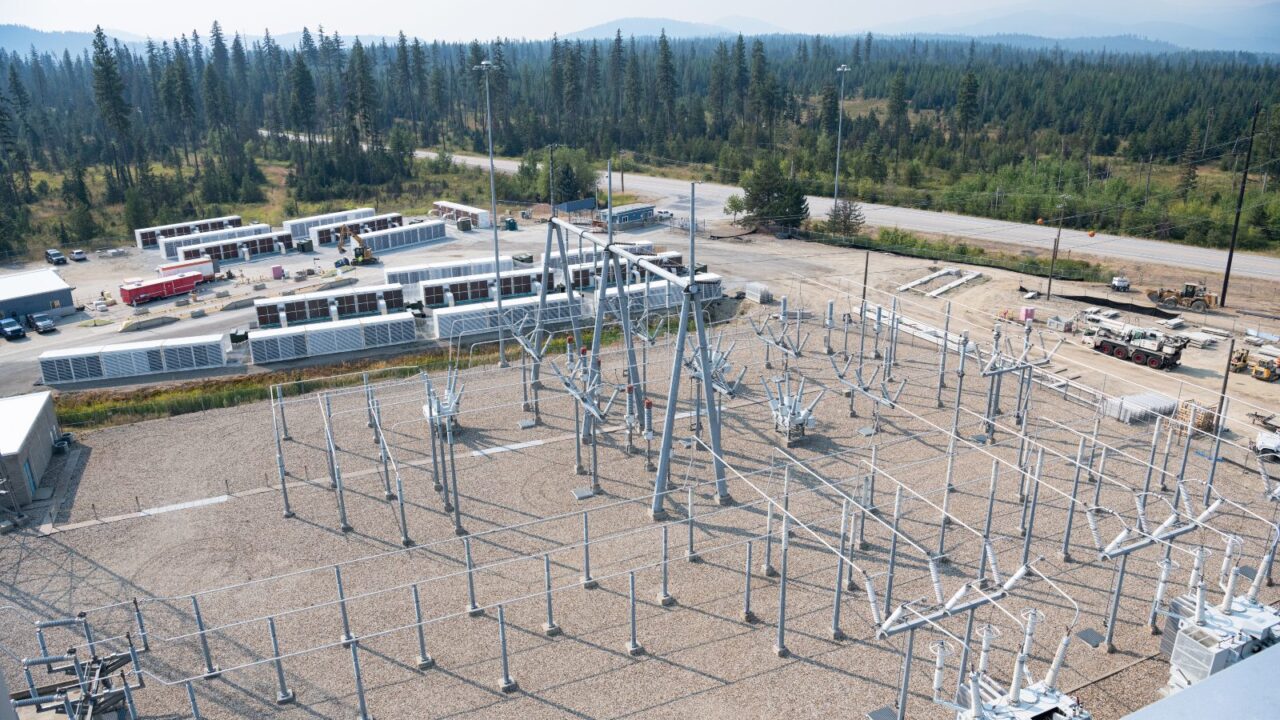Crypto Mining Regulation in the Pacific Northwest
Legislation in Washington and Oregon seeks to limit the industry’s ability to undermine clean air targets. One of the substations at Merkle Standard. Photo: Erick Doxey / InvestigateWest.
One of the substations at Merkle Standard. Photo: Erick Doxey / InvestigateWest.
More than a dozen cryptocurrency mining operations call Grant County, Washington, home.
In a county of just over 100,000 residents, sitting directly below the Grand Coulee Dam, 13 crypto mining operations—think warehouses stacked with networked computers continuously working on complex math equations to earn bitcoin—might seem like a lot. But the combined 27 megawatts of electricity those miners use today comprise only a fraction of the requests the Grant County Public Utility District has fielded since 2017, when bitcoin surged in value to nearly $20,000.
“We were getting inquiries that would have tripled our load for the county” back in 2018, said Christine Pratt, public information officer for the utility. “The actions we’ve taken have prepared us to deal with that type of customer fairly.”
The swell of crypto mining interest in the region was driven by some of the cheapest hydropower in the U.S. produced by the Grand Coulee and other dams. So the utilities in central Washington used tiered power rate increases to manage the high electricity usage that is characteristic of the industry. Fee schedules have also wound up being one of the few ways that any public authority in Washington has sought to regulate the crypto mining industry.
Several years of bitcoin’s boom-and-bust cycles later, environmental regulations around crypto mining have remained relatively sparse in Washington and the rest of the Pacific Northwest. Even at state agencies tasked with environmental protections beyond emissions, such as water quality or e-waste disposal, spokespeople echoed a common refrain that they have little or no specific insight into the impacts of bitcoin mining. Slowly, that’s beginning to change.
The targets for Oregon’s and Washington’s ambitious clean air laws, which seek to phase out nonrenewable energy sources from the states’ power grid in the next couple of decades, are growing closer. In response, lobbyists and policymakers have begun to focus on ensuring crypto mining’s high electricity use doesn’t wind up contributing to fossil fuel emissions after the deadlines pass.
In Oregon, House Bill 2816 seeks to extend emissions controls to the high-load customers of consumer-owned utilities that are the providers for crypto mining operations and data centers, closing what climate activists consider an important loophole. Existing laws only apply to investor-owned utilities, such as PacifiCorp and Portland General Electric, and electricity service suppliers.
“It really just made sense as a next step on this path toward 100% clean energy and making sure we’re meeting our target goals,” said OregonRep. Pam Marsh, D-Southern Jackson County, one of the co-sponsors of HB 2816.
In Washington, House Bill 1416 would apply clean energy standards to similar customers of municipal and public utilities, which are excluded from current law. They serve the majority of crypto mining operations, which are primarily located in central and eastern Washington. Glenn Blackmon, energy policy manager for the Washington Office of Energy, described the bill as one piece of a larger, ongoing conversation that the state needs about how to prioritize resources to meet its climate goals.
“We are also trying to transform other parts of our economy from fossil fuels to clean electricity,” Blackmon said. “(Crypto mining) certainly adds to the requirements that are already very large for us to build out our electric supply to meet our energy goals.”
Nationwide, the push to lessen crypto mining’s environmental toll has involved a mix of industry innovation and state regulation.
The fact that bitcoin mining uses so much electricity is no accident. It’s by design. Because bitcoin operates through a system called “proof of work,” its scarcity comes from the time and energy that each computer spends trying to solve the correct math equation that earns an amount of bitcoin. That system underpins both the value and the security of the currency. The other environmental effects of the industry include computers that wear out and need to be disposed of and replaced, and the use of coolant, usually water, for the servers as they work for hours at a time.
Those aspects of crypto mining have driven headlines about heated water being discharged back into lakes, prompting worries about fish death and algal blooms, and about closed coal plants being reopened to power crypto servers.
Concerns about the latter practice drove New York lawmakers in November to temporarily ban issuance and renewal of air permits to crypto mining companies that operate at fossil fuel plants. It also scandalized Washington Rep. Tana Senn when she first began learning about the industry a few years ago.
“(It) made my mind explode,” said Senn, D-Mercer Island, who is a member of the newly created HouseInnovation, Community and Economic Development and Veterans Committee. She started trying to learn everything she could about the industry.
Her perspective shifted during that time, she said. She learned about how utilities had increased fees to manage the demand, and how the Washington Department of Ecology’s water quality department monitors the water discharge practices of businesses such as crypto mining operations. It soothed her initial alarm.
“I realized we as a state could not legislate away crypto,” she said. And if crypto is going to exist, “Washington is a good place to have these things, instead of having them go to China or Texas or somewhere with no regulation and they can do even more damage.”
During the 2022 legislative session, she and counterparts in the Washington Senate successfully pushed for the creation of the Blockchain Work Group, to which she was appointed in May. That work group will study the application of blockchain tech in a variety of fields, including its environmental impacts. It’s not the first of its kind: Around a dozen states have already established similar work groups. In California and Wyoming, they have developed legislation already.
Washington’s block chain group was supposed to convene by December 2022, with its first report to Gov. Jay Inslee due by December 2023. But in an early January interview, Senn said the group had not had its first meeting yet.
“It’s kind of frustrating,” she said.
Jim Kopriva, spokesperson for Inslee, expressed a less than favorable view of crypto mining’s contributions to the state, but referred only briefly to the legislative fix currently being pursued.
Kopriva said the governor is “generally aligned with the Biden administration regarding cryptocurrency’s energy use implications.”
“Mining hogs energy and generates few jobs, and our energy infrastructure must prioritize Washingtonians’ energy demands,” he said. “Future legislation might close loopholes to insist that energy-intensive industries procure clean, renewable energy consistent with our state laws.”
Nationwide, the push to lessen crypto mining’s environmental toll has involved a mix of industry innovation and state regulation. The Bitcoin Mining Council, for example, formed in 2021, represents perhaps the broadest industry-driven effort to begin a conversation about the energy usage of bitcoin mining. It attempts to track the power mix for bitcoin mining. Its latest quarterly report estimated that 58.9% of the energy consumed globally in mining came from sustainable sources like hydro.
Individual operations say they are also embracing sustainable practices. In Pend Oreille County in the northeast corner of Washington, the Merkle Standard crypto mining operation is one example. On its website, it says it expects to be net carbon negative by the end of this year. For now, it buys renewable energy credits to offset the impacts of potential fossil fuel sources in its electrical mix. The company did not answer a question about what percentage of its total energy usage it is attempting to offset through renewable energy credits.
The White House released a landmark series of reports in September that sought to capture the nationwide impact of the industry.
InvestigateWest visited Merkle Standard’s facility in Usk in October shortly after it became operational.
The company currently has permission to use up to 100 megawatts of energy per year, but has signed a deal with its business partner to use up to 500 megawatts. It will take significant infrastructure investments, which could take years to build, to realize that goal, company executives said.
So far, federal action around crypto largely has been limited to studies.
The White House released a landmark series of reports in September that sought to capture the nationwide impact of the industry. It included a number of striking statistics, including an estimate that crypto mining now accounts for about 1% of the electricity consumed in the country and produces between 25 and 50 million metric tons of carbon dioxide annually—that’s comparable to the diesel fuel emissions produced by the nation’s trains.
One report also stated that the industry produces more than 30,000 tons of electronic waste each year, the equivalent of all the electronic waste generated by the Netherlands.
Crypto industry advocates such as the Blockchain Association criticized the Biden administration’s reports, calling them a “missed opportunity” that disproportionately focused on the risks associated with the industry without providing solutions to improve access and security.
In response to the White House findings, U.S. Sen. Edward Markey, D-Mass., and U.S. Rep. Jared Huffman, D-Calif., introduced the Crypto-Asset Environmental Transparency Act in December. U.S. Sen. Jeff Merkley, an Oregon Democrat, is a co-sponsor.
The bill would require the Environmental Protection Agency to conduct a comprehensive impact study of U.S. crypto mining activity and require crypto mining operations that use more than 5 megawatts of power to report their greenhouse gas emissions.
Oregon and Washington, meanwhile, are working to ensure crypto mining operations eventually can’t buy power from nonrenewable sources in order to meet their energy demands.
Oregon’s clean energy targets require the state’s investor-owned utilities to reduce greenhouse gas emissions to 80% below baseline emissions levels by 2030; 90% by 2035; and 100% by 2040.
Washington’s Clean Energy Transformation Act requires utilities to phase out coal-fired electricity from their state portfolios by 2025. By 2030, their portfolios must be greenhouse gas emissions neutral, allowing them to use limited amounts of electricity generated from natural gas as long as it is offset by other actions, such as renewable energy credits. By 2045, utilities must provide electricity from 100% renewable sources, with no ability to use offsets.
Joshua Basofin, Oregon clean energy policy manager with environmental nonprofit Climate Solutions, said advocates had realized over the last couple of years the potential for data centers and crypto mining operations to contribute to ongoing carbon emissions under House Bill 2021, Oregon’s climate law passed in 2021. They wanted to close the loophole.
“Data centers and crypto have been very attracted to Oregon,” Basofin said. “We were thinking it would be great if there was parity with HB 2021 for these other big loads. Crypto is not quite as developed here, but I think there’s big potential for it to grow.”
“Climate change is real, it’s impacting our communities and we need to hold our big energy users to the standard we’re holding our big utilities,” Marsh said.
Oregon and Washington both still have a double-digit percentage of their energy supply to wean off nonrenewables, according to data from both states.
The most recent figures posted by the Oregon Department of Energy on the statewide power generation resource mix showed coal accounted for 26% of the electricity on the state grid in 2020, followed by 21% coming from natural gas. Hydro power made up 40% and wind 7%.
Washington’s hydro power share was higher, approximately 55%, but its electric utilities’ overall resource mix still included about 10% from coal as of 2020, according to data from the Washington Department of Commerce. Nearly 13% came from natural gas, while wind and nuclear combined made up 9%.
The gravity and scale of the task ahead are why statewide policymakers are trying to strike a balance between quashing the crypto mining industry and throwing open the doors for more energy to be diverted to bitcoin miners.
“Even if they are building their own new clean resources, it still could compete for a scarce resource, which is new clean electricity sources,” Blackmon of the Washington Energy Office said.
“Meanwhile, there are other novel uses that we’re pretty interested in, too, and would tend to rank them more valuable than crypto.”
Your support is crucial...As we navigate an uncertain 2025, with a new administration questioning press freedoms, the risks are clear: our ability to report freely is under threat.
Your tax-deductible donation enables us to dig deeper, delivering fearless investigative reporting and analysis that exposes the reality beneath the headlines — without compromise.
Now is the time to take action. Stand with our courageous journalists. Donate today to protect a free press, uphold democracy and uncover the stories that need to be told.







You need to be a supporter to comment.
There are currently no responses to this article.
Be the first to respond.